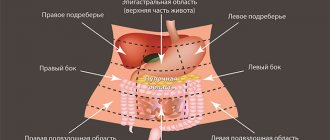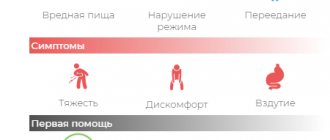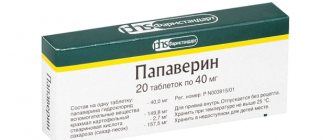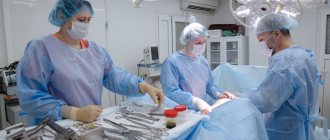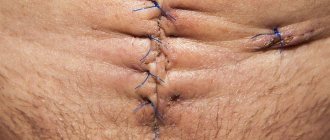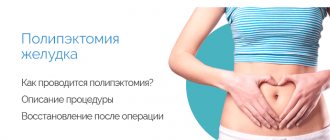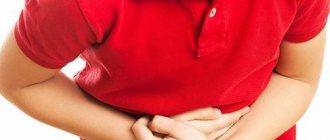The appearance of cutting pain after eating is a typical phenomenon for those who eat junk food. If a person regularly eats fatty, fried, salty or sweet foods, it will be difficult to avoid pain and damage to the intestines. However, the process of pain is affected not only by poor nutrition, but also by irregular nutrition. The stomach is susceptible to prolonged fasting and begins to produce excess gastric juice. Soon, patients develop gastritis, which develops into a duodenal ulcer.
If you have complaints about the gastrointestinal tract, you should consult a doctor. In a private clinic called “KDS Clinic” you will be provided with consultation and prescribed effective and inexpensive treatment. At our medical facility, you can undergo examinations to diagnose the disease even at an early stage. Our staff regularly undergoes advanced training courses.
We invite you to read reviews about our medical staff on the official website of the KDS Clinic. Afterwards, you can decide on the doctor with whom you would like to make an appointment and find out the prices. The site also contains information about medical examinations, the process of conducting them, as well as indications and contraindications.
Easy to say, hard to do
Even when trying to stick to a regular diet, we use ready-made foods, fast food, and confectionery.
It turns out that seemingly healthy food hides an excess of fats, preservatives, sugar and other food additives. The amount of fiber, proteins, and slow carbohydrates leaves much to be desired. This may not have the best effect on digestion. If we haven’t eaten well during the day, in the evening we want to reward ourselves for our hard work and have a little belly celebration. Since childhood, we were taught to finish everything. Now this can lead to stomach discomfort after eating. It's good if this happened a few hours before bedtime. But if overeating occurs before bed, not only the evening can be ruined. Heaviness in the stomach after eating can interfere with sleep, and in the morning you get up with a “brick” in your stomach and a “cast iron” head.
We start watching our diet, vowing to ourselves to eat right, but only from Monday, and tomorrow we will have a birthday feast or a party with friends. Well, how can I refuse here?
Unfulfilled promises are forgotten, and abdominal discomfort, bloating, flatulence and other problems can haunt us constantly. Many try not to notice this or simply say that their stomach is naughty.
Abdominal pain in a small child
Abdominal pain in a child is a pathology that all parents face. The cause of pain can be a wide range of diseases and pathological conditions, such as: overeating, flatulence, constipation, intolerance to certain foods, intestinal infections, food poisoning, urinary tract infections, appendicitis, intussusception and many others.
In some cases, abdominal pain does not have a clearly defined physiological cause. As a rule, abdominal pain disappears after two to three hours. In some cases, however, pain may persist for much longer.
Factors that provoke abdominal pain in an infant may be incorrectly selected formulas or a sharp transition from one type of food to another (for example, replacing Nutrilon baby food with Nan).
In what cases should you consult a doctor? When acute pain appears in a teenager, first of all, it is necessary to exclude a number of diseases united by the concept of “acute abdomen”. Such diseases include acute pathology of the abdominal organs, in which emergency surgical care is vital: acute appendicitis, perforated gastric or intestinal ulcer, peritonitis, intussusception, etc.
Along with intense pain, an “acute abdomen” is characterized by a sharp deterioration in health, dry mouth, tachycardia, and possibly an increase in body temperature. The following symptoms may be a reason to seek emergency medical help:
- Acute pain continues in the child for more than two hours.
- The pain is cramping in nature and lasts more than 12 hours.
- The child began vomiting, including blood or bile.
- Blood in stool.
In cases of acute pain that lasts several hours, you should immediately contact your pediatrician.
If your child has abdominal pain, have him lie down for 10-15 minutes. After a short rest he will probably feel better. Sometimes a warm heating pad helps relieve unpleasant symptoms. Give your child plenty of fluids and avoid rough, hard foods. Only the attending physician can prescribe laxatives or enemas to the child.
When the cause of pain is acute appendicitis (inflammation of the appendix), the pain is usually localized in the navel area and then moves down and to the right. Sometimes the pain spreads to the lower abdomen.
As a rule, in such cases, the child’s temperature rises in the evening and vomiting begins. If your child has symptoms of appendicitis, contact your pediatrician immediately. In such a situation, delay can result in serious complications.
In young children, the equivalent of abdominal pain is screaming, crying, restlessness, refusal to eat, a crouched posture with the legs brought to the stomach, impulsive movements of the legs (“kneeling”).
Severe paroxysmal restlessness in a child under 1 year of age, accompanied by vomiting, bloating, and blood in the stool, may be due to a serious disease - intussusception. This disease requires urgent medical attention.
Note: In advanced cases, surgical interventions may be required, sometimes more than once.
Acute abdominal pain sometimes occurs in children with an acute respiratory viral infection. It is necessary to take into account the epidemiological situation in the children's group and at home. When examining a child, you should pay attention to the moderate severity of catarrhal phenomena in the nasopharynx, high body temperature, intoxication, and sometimes arthralgia.
Sometimes the cause of abdominal pain can be emotional stress associated with an unfavorable psychological climate at home or at school. For a school-age child, such stress is a common occurrence. The cause of stress can be divorce or other family troubles, problems in relationships with peers, with teachers.
Some children experience abdominal pain every morning, and this is most often associated with nervous tension before the start of the school day. Such pains usually disappear within 24 hours; If necessary, allow the child to stay at home. Try to identify the main cause of emotional stress and solve the problem as soon as possible.
How does abdominal discomfort occur after eating?
Many associate discomfort after eating with the stomach. But if you look at it, it turns out that the main processes of food digestion take place in the intestines. Of course, it is important what we eat, how we chew food, but in the end the “conductor of digestion” is the pancreas. It is she who produces special digestive enzymes, which in the intestines break down food (proteins, fats and carbohydrates) into simpler elements, helping the body digest and absorb it.
If for some reason there are not enough enzymes, then after eating you may experience discomfort, heaviness, bloating, and flatulence.
Why can sweets cause heartburn?
An unpleasant burning sensation behind the sternum has a direct connection with nutrition. An excess of simple carbohydrates in the diet can increase acid production and also provoke increased gas formation1. Both parameters increase the risk of food reflux from the stomach into the esophagus, which can cause heartburn.
Carbohydrate foods that may cause burning include:
- chocolate;
- cakes, butter cookies;
- sweet carbonated drinks;
- sweet coffee and tea;
- any baked goods;
- fruit juices with sugar;
- sweets2,3.
Not every person gets heartburn from sweets. The risk of developing a symptom increases if there are additional factors:
- binge eating;
- eating fried, fatty foods;
- smoking;
- alcohol consumption;
- overweight;
- pregnancy;
- wearing tight belts;
- excessive physical activity after eating, especially bending;
- horizontal position after eating3.
The occurrence of heartburn after eating sweets more than once a week for several months may indicate the development of gastroesophageal reflux disease2. Main symptoms: heartburn and sour belching3. The disease occurs due to persistent weakening of the muscular sphincter between the stomach and esophagus2.
Useful tips
Every effort should be made to restore the normal functioning of the digestive system and look at your lifestyle from a different perspective.
What can help2:
- Stable daily routine and food intake. Normalizing biological rhythms helps the body get used to the timely production of enzymes for digesting food.
- Fractional meals - eating small portions up to 5 times a day to prevent overeating and maintain a routine. You can carry a snack in the form of nuts and dried fruits with you so as not to buy confectionery.
- Chewing thoroughly and eating in moderation.
- Balanced food composition. Particular attention should be paid to the composition of ingredients when purchasing ready-made dishes.
- Sufficient amount of water. Drink 1 glass of warm water 20 minutes before meals to reduce appetite.
- Minimum daily physical activity. You can replace taking the elevator with a walk up the stairs, or try to walk more.
- Eliminate bad habits such as alcohol and smoking.
It’s not easy to follow all the recommendations at once. And the effect of their use will not be noticeable immediately.
Treatment of abdominal pain
If your stomach hurts, doctors can use two treatment methods - surgery or a conservative method. Sometimes it is necessary to undergo surgery (appendicitis, intestinal obstruction) to save a life.
The most important thing is to visit a specialist on time. He will study the whole picture and prescribe the necessary treatment. If your stomach hurts, you get tested and all the research is done. Based on this, a diagnosis is already made.
Self-medication is unacceptable; medications should be used only after diagnosis and consultation with a doctor.
Everything is quite simple here; you can use some methods when there is pain in the lower abdomen:
- Eat prunes if your lower abdomen hurts. You can also take any product that contains a lot of dietary fiber (broccoli, bran). Prunes are especially useful in such situations because they contain sorbitol (a laxative of natural origin).
- Drink tea that has been made from ginger, chamomile, or peppermint. Such herbs reduce nausea and help with abdominal pain. With the help of ginger you can normalize digestion, chamomile and mint will help relieve muscle spasms.
- Use baking soda and make an aqueous solution. Baking soda is found in most antacid medications. It’s worth taking 1 tbsp. l. baking soda and dilute with warm water (1 cup).
- Get a massage if your stomach hurts during your period. Spasms may occur inside due to the muscles being too tense. You will need a light massage, focusing on the place where it hurts the most.
- Take a hot water bath before bed. Water will relax muscles, improve blood circulation, and relieve pain. You need to lie down for about 20 minutes. If a woman has a stomach ache, you can throw Epsom salts into the bath.
How to help digestion?
To compensate for the lack of digestive enzymes of the pancreas, pancreatin enzyme preparations can be used. They help improve food digestion. Helping with fat digestion is especially important. The required enzyme for this is lipase, which is produced only by the pancreas. At other stages of digestion, except for the intestines, it is simply not there2. Therefore, when choosing an enzyme preparation, its quantity is so important. How to figure it out?
The most common and familiar drug for improving digestion is pancreatin in tablet form3. Pancreatin is the active ingredient of an enzyme preparation to improve digestion, but this does not mean that pancreatin preparations are all the same.
Since we started with the lipase content in the drug, it is worth noting that tablet forms of pancreatin can contain from 25 units (IU) of lipase. There are a number of drugs in which this amount may be higher: 3500–4500 IU of lipase. The optimal amount of lipase that should be contained in an enzyme preparation in case of dietary errors is recognized to be 10,000 units4.
But the most important thing in choosing a drug is not even the amount of lipase. The defining property is the release form5,6.
Studying the necessary conditions for the effective operation of the enzyme preparation, scientists came to the conclusion: the preparation must have small particles of the active substance. And the size of these particles should not exceed 2 mm5,6.
The tablet form is recognized as the least effective for an enzyme preparation, since it does not allow the drug to work physiologically6,7, which means to precisely integrate into an already working system and get to where the enzymes work in natural conditions.
Diagnostics
The following signs of pain should be determined: location, type (acute, chronic), nature (perforated, burning, dull, pressing, colicky, spastic, pulling), intensity, factors provoking or modifying pain (especially eating and drinking, vomiting, defecation, body position).
During an objective examination, one should evaluate the patient’s general appearance, vital parameters (respiration, pulse, blood pressure), skin color, the presence of hernias, ascites, bloating, scars, venous collaterals, the place of greatest palpation pain, the presence of tumors, muscle protection and other peritoneal symptoms, the presence and nature of peristaltic bowel sounds, the presence of hepatic dullness.
It is necessary to exclude the presence of threatening symptoms indicating an organic disease requiring urgent diagnosis or surgical treatment:
- acute abdominal pain with nausea, vomiting or acute stool retention - indicates obstruction of the digestive tract;
- acute abdominal pain with bleeding from the digestive tract - may indicate a gastric or duodenal ulcer, acute hemorrhagic gastropathy, intestinal ischemia or bleeding into the intestinal lumen (for example, rupture of an abdominal aortic aneurysm);
- acute abdominal pain with rapid deterioration of the patient's condition (hypotension, impaired consciousness, respiratory failure) - may indicate intra-abdominal bleeding, perforation of the digestive tract, acute pancreatitis, acute liver failure;
- chronic abdominal pain and the presence of blood in the stool or weight loss - may be a symptom of cancer or nonspecific intestinal inflammation;
- abdominal pain and detection of pathological signs on physical examination (eg jaundice, abdominal tumor);
- abdominal pain at night (wakes the patient up).
Common causes of abdominal pain depending on its location
| Localization | Causes |
| Right upper quadrant | Cholecystitis or cholangitis, biliary colic, acute hepatitis, pancreatitis, esophagitis, peptic ulcer of the stomach and duodenum, nonspecific colitis, intestinal obstruction, appendicitis with a retrocecal location, renal colic, pyelonephritis, subphrenic abscess, inflammation of the lower lobe of the right lung, congestive heart failure ( congestive liver) |
| Epigastric region | Functional dyspepsia, gastroesophageal reflux disease, drug-induced gastritis and duodenitis, peptic ulcer of the stomach and duodenum, gastroenterocolitis, biliary tract diseases, acute hepatitis, pancreatitis or pancreatic pseudocysts, malignant tumors (stomach, pancreas, colon), intestinal ischemia, aneurysm abdominal aorta, myocardial infarction |
| Upper left quadrant | Rupture or infarction of the spleen, pancreatitis and pseudocysts of the pancreas, ischemia of the splenic flexure of the colon, renal colic, pyelonephritis, subphrenic abscess, inflammation of the lower lobe of the left lung |
| Right and left mesogastrium | Renal colic, pyelonephritis, kidney infarction, nonspecific colitis, intestinal obstruction, hernia |
| Periumbilical region | Early stage of appendicitis, gastroenterocolitis, intestinal obstruction, nonspecific colitis, intestinal ischemia, pancreatitis, abdominal aortic aneurysm, hernia |
| Lower right quadrant | Appendicitis, small and large intestines (obstruction, nonspecific colitis, ileocecal intussusception), genitourinary tract (renal colic, pyelonephritis, adnexitis, ovarian cyst, ovarian torsion, ovarian rupture, ectopic pregnancy), abscess (pelvic, lumbar), purulent sacroiliitis, hernia |
| Hypogastric region | Appendicitis, diverticulitis, intestinal obstruction, nonspecific colitis, irritable bowel syndrome, inflammation of the appendages, pelvic inflammatory processes, renal colic, cystitis, pelvic abscess, hernia |
| Lower left quadrant | Acute diverticulitis, infectious diseases, nonspecific colitis, intussusception of the sigmoid colon, irritable bowel syndrome, renal colic, pyelonephritis, adnexitis, ovarian cyst, ovarian torsion, ovarian rupture, ectopic pregnancy, sacroiliitis |
| Pain of a diffuse nature | Infectious and non-infectious gastritis and enterocolitis, intestinal obstruction, peritonitis, urinary tract infection |
It is necessary to conduct basic additional examinations: blood morphology, levels of electrolytes, creatinine and glucose in the blood serum, general urinalysis, ECG. Subsequent additional examinations of blood, urine and feces depend on the primary diagnosis and the need for differential diagnosis: the level of amylase, bilirubin, CK-MB or cardiac troponin, the activity of AST, ALT, GGT and alkaline phosphatase, stool analysis for the presence of occult blood.
Primary diagnostic imaging methods: ultrasound (can detect the presence of free fluid in the abdominal cavity, urinary and gallstones, anomaly of the abdominal aorta) and plain X-ray of the abdominal cavity (can detect the presence of air in the abdominal cavity, fluid levels in intestinal loops, urinary calculi).
Note: If you have symptoms of an acute abdomen or if the cause of acute abdominal pain is unclear, you should consult a surgeon.
